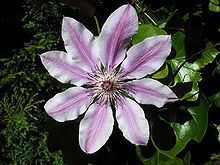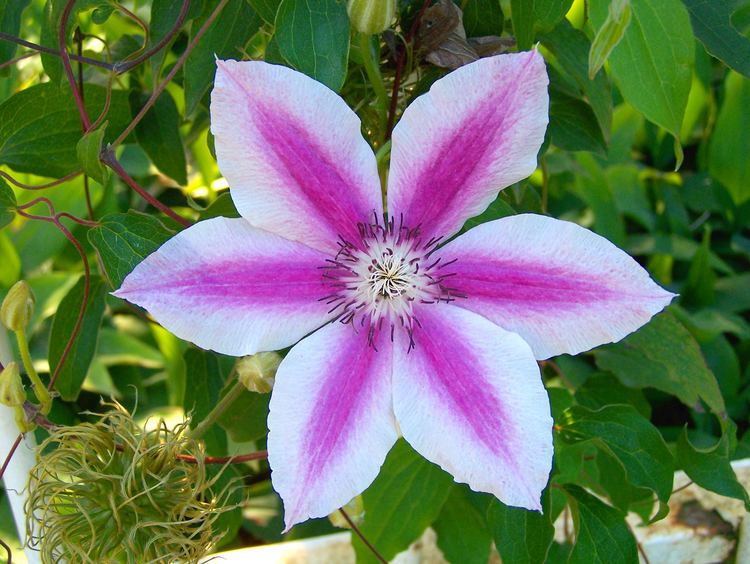Tribe Anemoneae | Subfamily Ranunculoideae Scientific name Clematis | |
 | ||
Lower classifications Asian virginsbower, Clematis vitalba, Clematis 'Jackmanii', Clematis montana, Clematis alpina | ||
How to plant a clematis
Clematis is a genus of about 300 species within the buttercup family Ranunculaceae. Their garden hybrids have been popular among gardeners, beginning with Clematis × jackmanii, a garden standby since 1862; more hybrid cultivars are being produced constantly. They are mainly of Chinese and Japanese origin. Most species are known as clematis in English, while some are also known as traveller's joy, a name invented for the sole British native, C. vitalba, by the herbalist John Gerard; virgin's bower for C. viticella; old man's beard, applied to several with prominent seedheads; leather flower for those with fleshy petals; or vase vine for the North American Clematis viorna.
Contents
- How to plant a clematis
- Best plants for morning sun afternoon shade clematis
- Etymology
- Botany
- Species
- Formerly placed here
- Subdivisions
- Garden history
- Cultivation
- Pruning
- Cultivars
- Horticultural classification
- Use and toxicity
- Pests and diseases
- References

Best plants for morning sun afternoon shade clematis
Etymology
The genus name is from Ancient Greek clématis, ("a climbing plant"). Over 250 species and cultivars are known, often named for their originators or particular characteristics.
Botany

The genus is composed of mostly vigorous, woody, climbing vines / lianas. The woody stems are quite fragile until several years old. Leaves are opposite and divided into leaflets and leafstalks that twist and curl around supporting structures to anchor the plant as it climbs. Some species are shrubby, while others, like C. recta, are herbaceous perennial plants. The cool temperate species are deciduous, but many of the warmer climate species are evergreen. They grow best in cool, moist, well-drained soil in full sun.

Clematis species are mainly found throughout the temperate regions of the Northern Hemisphere, rarely in the tropics. Clematis leaves are food for the caterpillars of some Lepidoptera species, including the willow beauty (Peribatodes rhomboidaria).

The timing and location of flowers varies; spring-blooming clematis flower on side shoots of the previous year's stems, summer/fall blooming clematis bloom only on the ends of new stems, and twice-flowering clematis do both.
Species
A partial list of species:

Formerly placed here
Subdivisions

One recent classification recognised 297 species of clematis, so it is not surprising that taxonomists and gardeners subdivide the genus. Several classification systems exist.
Magnus Johnson divided Clematis into 19 sections, several with subsections. Christopher Grey-Wilson divided the genus into 9 subgenera (Clematis, Cheiropsis, Flammula, Archiclematis, Campanella, Atragene, Tubulosae, Pseudanemone, Viorna), several with sections and subsections within them. Several of the subdivisions are fairly consistent between these two systems; for example, all of Grey-Wilson's subgenera are used as sections by Johnson. Alternatively, John Howell defined twelve groups: the Evergreen, Alpina, Macropetala, Montana, Rockery, Early Large-Flowered, Late Large-Flowered, Herbaceous, Viticella, Texensis, Orientalis, and Late Mixed groups. Thorncroft Clematis, published their catalogue of 2000 with 8 subdivisions of clematis which was refined by 2006 to 16, those being Armandii, Atragene, Cirrhosa, Diversifolia, Flammula, Florida, Forsteri, Heracleifolia, Integrifolia, Montana, Tangutica, Texensis, Viticella, Early Large Flowered, Late Large Flowered and Species. For the most part the gardening public can understand these groups easily and yet this grouping system also offers enough diversity to divide clematis into meaningful groups for classification purposes. The RHS published its International Clematis Register and Checklist 2002 which acknowledges Wim Snoeijer of The Netherlands as the proposer of some of these new groups and he also influenced Thorncroft Clematis in the way their subdivisions were established.
Many of the most popular garden forms are cultivars belonging to the Viticella section of the subgenus Flammula as defined by Grey-Wilson. These larger-flowered cultivars are often used within garden designs to climb archways, pergolas, or wall-mounted trellises, or to grow through companion plants. These forms normally have large 12–15 cm diameter upward-facing flowers and are believed to involve crosses of C. patens, C. lanuginosa, and C. viticella. Early-season, large-flowering forms such as 'Nelly Moser' tend towards the natural flowering habit of C. patens or C. lanuginosa while later-flowering forms such as ×jackmanii are nearer in habit to C. viticella.
Garden history
The wild Clematis species native to China made their way into Japanese gardens by the 17th century. Japanese garden selections were the first exotic clematises to reach European gardens, in the 18th century, long before the Chinese species were identified in their native habitat at the end of the 19th century.
After it arrived in Europe, it acquired several meanings during the Victorian era, famous for its nuanced flower symbolism. It came to symbolize both mental beauty and art as well as poverty.
Cultivation
The climbing varieties are valued for their ability to scramble up walls, fences, and other structures, and also to grow through other plants, such as shrubs and trees. Some can be trained along the ground to provide cover. Because of their adaptability and masses of spectacular flowers, clematis are among the most popular of all garden plants. Many choice and rare cultivars are to be had from mail order and online catalogues. Specialists regularly put on displays in national flower shows such as the Chelsea Flower Show. In theory, it is possible to have a clematis in flower at any time throughout the year. Many varieties provide a second period of interest with a flush of flowers, or decorative seed heads.
They will grow in any good garden soil. The roots usually require a moist, cool substrate, while the herbage can take full sun. Some more delicate cultivars such as 'Nelly Moser' do better in light shade. Many clematis can be grown successfully in containers.
Pruning
The pruning regime for a cultivated clematis falls into three categories:
Cultivars
Over 80 varieties and cultivars have gained the Royal Horticultural Society’s Award of Garden Merit.
In the Atragene group are woody deciduous climbers with bell-shaped flowers in spring, produced on the last year’s growth. These include 'Markham’s Pink', a pale pink breed.
In the early large-flowered group, which flower on the last year’s growth, are:
In the Clematis integrifolia group (or Integrifolia group) are non- or semiclimbing plants that flower on the current year's growth. These include the violet-pink 'Arabella'.
In the late large-flowered group, which flower on the current year's growth, are:
In the Clematis montana group (or Montana group) are vigorous climbers that flower in spring, such as:
In the Clematis viticella group (or Viticella group) are compact deciduous climbers with small flowers produced on the current year’s growth, such as:
Other breeds include:
For further details see the List of Award of Garden Merit clematis.
Horticultural classification
This follows the classification adopted by V. Matthews in The International Clematis Register and Checklist 2002, except that C. ispahanica, now considered to have been included in error, has been omitted from the list of parent species in Tangutica Group.
Use and toxicity
The European species did not enter into the herbalists' pharmacopeia. In the American Old West, the Western white clematis, Clematis ligusticifolia, was called pepper vine by early travelers and pioneers, who took a tip from Spanish colonials and used seeds and the acrid leaves of yerba de chivato as a pepper substitute. The entire genus contains essential oils and compounds which are extremely irritating to the skin and mucous membranes. Unlike black pepper or Capsicum, however, the compounds in clematis cause internal bleeding of the digestive tract if ingested in large amounts. C. ligusticifolia is essentially toxic. When pruning them, it is a good idea to wear gloves. Despite its toxicity, Native Americans used very small amounts of clematis as an effective treatment for migraine headaches and nervous disorders. It was also used as an effective treatment of skin infections. Clematis is also a constituent of Bach's Rescue Remedy. Leaf extracts from two Ethiopian species (Clematis longicauda steud ex A. Rich. and Clematis burgensis Engl.) are used locally to treat ear disorders and eczema. Phytochemical screening of the extracts from both of these species showed antibacterial and antifungal activity. The extracts of these plants also possess wound healing and anti-inflammatory activities which could also be attributed to the phytoconstituents.
Clematis has been listed as one of the 38 plants used to prepare Bach flower remedies, a kind of alternative medicine promoted for its effect on health. However, according to Cancer Research UK, "there is no scientific evidence to prove that flower remedies can control, cure or prevent any type of disease, including cancer".
Pests and diseases
Clematis species are susceptible to several pests and diseases. Clematis wilt, a stem rot caused by the fungus Phoma clematidina, causes dramatic wilting and death of whole branches, although many species are resistant to it. Other pests and diseases include powdery mildew, viruses, slugs and snails, scale insects, aphids, earwigs, and green flower disease, which is usually caused by infection with a phytoplasma, a type of bacterium.
